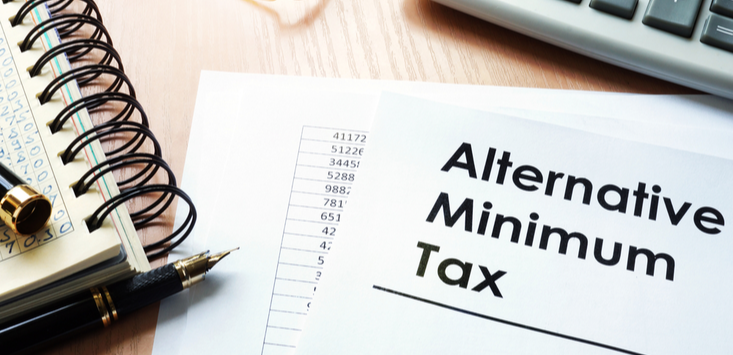What is an Alternate Minimum Tax or AMT?
Alternate Minimum Tax or AMT is the minimum amount of tax that the Government levies on individuals and companies. It is an alternate minimum tax to the normal tax levied by the Government. The rate at which is applied at 18.5%, excluding surcharge and cess. Alternate Minimum Tax has to be paid by the taxpayer.
The primary purpose of the Alternate Minimum Tax levied on individuals is to ensure that the country's taxpayers do not misuse the tax deductions. Moreover, it also ensures the Government that the taxpayers do not escape from paying the entire amount of taxes.
Let us now see who all have to pay the Alternate Minimum Tax or AMT to the Government.
Who All Have to Pay the Alternate Minimum Tax?
1. Non-corporate taxpayers
This includes individuals, Hindu Undivided Families (HUFs), Associations of Persons (AOPs), Body of Individuals (BOIs), and artificial juridical persons whose adjusted total income exceeds Rs. 20,00,000.
2. Taxpayers who have claimed deductions under the following –
- Chapter VI-A. Under this chapter, under Section 80H to 80RRB taxpayers who are gaining profits and gains of specific industries such as hotel business, housing projects, export business, etc., or
- capital expenditure that is incurred by the taxpayer for business such as cold chain facility, fertilizer production etc. This comes under deductions under Section 35AD.
- Profit linked deductions that are mentioned under Section 10AA
Let us now see who all are exempted from paying the Alternate Minimum Tax or AMT to the Government.
Who All are Exempted from Paying the Alternate Minimum Tax?
- Individuals
- Hindu Undivided Family (HUF)
- Association of Persons (AOP)
- Body of Individuals (BOI)
- Artificial juridical people whose adjusted total income is less than Rs 20,00,000.
Let us now see how to calculate Alternate Minimum Tax with an example :
How to Calculate Alternate Minimum Tax or AMT?
- The taxpayer first needs to calculate the amount of tax liability. The taxpayer should also include any deductions under Section 10AA, Section 80H to 80RRB Section 35AD, etc. If the taxpayer has claimed, then he or she has to add to the tax liability.
- After including these deductions, you will get your adjusted income. 18.5% plus surcharge and cess of the Alternate Minimum Tax will then be applied to the adjusted income of the taxpayer.
Discover Tax Savings: Calculate your income tax with ease and explore the tax slabs for 2023-24.
Example of How to Calculate Alternate Minimum Tax
- Let us assume that your taxable income is that of Rs. 20 lakhs
- The deductions that you have claimed is Rs 25,000. Sor, now your adjusted income will of Rs. 2,25,000.
- The taxpayer's final adjusted income is Rs. 2,25,000 upon which 18.5% plus surcharge and cess of the Alternate Minimum Tax will be applicable.
We often must have come across the term Alternate Minimum Tax Credit. Do you know what exactly we mean by this term? Let us help you understand.
Wellness Starts Here: Take a step towards wellness by calculating your BMI. Our Online Body Mass Index Calculator provides you with valuable insights for a healthier you.
What is an Alternate Minimum Tax Credit?
In a situation where the tax due is higher under the Alternate Minimum Tax calculations the taxpayer has paid the excess due amount. In the following years, they are liable to claim a certain amount, also known as credit, depending on how much Alternate Minimum Tax has been paid. In other words, the Alternate Minimum Tax can be forwarded to the coming years. This is known as the Alternate Minimum Tax Credit.
Let us now understand what we mean by Alternate Minimum Tax Report
What is Alternate Minimum Tax Report?
The taxpayer who is liable to pay the Alternate Minimum Tax or AMT to the Government has to provide a report with the calculations. For this, the taxpayer has to get Form 29C filed by a Chartered Accountant (CA). The report will then be attached with the taxpayer's Income Tax Return(ITR) when it is filed.
The taxpayer filing for the Alternate Minimum Tax report should have all the details of the report that are required well in advance so that he or she does not face any hassle in the future and can seamlessly file for the Alternate Minimum Tax report. Let us now see the details of the report that are required.
What are the details of the report to be provided by the taxpayer?
- The name of the taxpayer
- Address of the taxpayer
- PAN details of the taxpayer
- The assessment year for the financial year 2021-2022
- Total income of the taxpayer
- The total tax payable based on this income of the taxpayer
- The deductions that are claimed under Sections 80H to 80RRB (except 80P) by the taxpayer
- The deductions that have been claimed under Section 10AA by the taxpayer
- The deductions that have been claimed under Section 35AD by the taxpayer, including the depreciation as allowed by Section 32
- The adjusted total income of the taxpayer
- Alternate Minimum Tax of the taxpayer
Budget with Confidence: Build your budget on accurate figures. Our Online Loan EMI calculator ensures you're well-prepared for your financial obligations.
